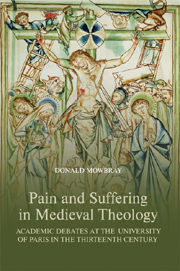 Pain and Suffering in Medieval Theology
Pain and Suffering in Medieval Theology Book contents
- Frontmatter
- Contents
- Acknowledgements
- Abbreviations
- Dedication
- Introduction
- 1 Thirteenth-Century Theological Ideas about Human Pain and Suffering and the Passion of Christ
- 2 Gendering Pain: Theological Ideas about Female and Male Suffering
- 3 Pain as a Restorative Power: Voluntary Suffering and Satisfaction for Sin
- 4 The Intellectual Development of Limbo: Pain, Children and Original Sin
- 5 Anima Separata: Masters of Theology and the Controversy surrounding the Suffering of the Separated Soul
- 6 Defining the Corporeal: Suffering in Hell according to Masters of Theology at Paris, c.1230–c.1280
- Conclusion
- Select Bibliography
- Index
2 - Gendering Pain: Theological Ideas about Female and Male Suffering
Published online by Cambridge University Press: 12 September 2012
- Frontmatter
- Contents
- Acknowledgements
- Abbreviations
- Dedication
- Introduction
- 1 Thirteenth-Century Theological Ideas about Human Pain and Suffering and the Passion of Christ
- 2 Gendering Pain: Theological Ideas about Female and Male Suffering
- 3 Pain as a Restorative Power: Voluntary Suffering and Satisfaction for Sin
- 4 The Intellectual Development of Limbo: Pain, Children and Original Sin
- 5 Anima Separata: Masters of Theology and the Controversy surrounding the Suffering of the Separated Soul
- 6 Defining the Corporeal: Suffering in Hell according to Masters of Theology at Paris, c.1230–c.1280
- Conclusion
- Select Bibliography
- Index
Summary
As the previous chapter showed, pain and suffering were key topics of discussion in theological treatises. Understanding them was essential to explaining the complex relationship of body and soul. Pain was a human experience but, according to thirteenth-century theological perceptions, did it pertain to both sexes equally? This chapter examines three areas of theology in which masters of theology discussed the nature of males and females: creation, the state of innocence and the Fall. In each context, it is to be determined to what extent the masters linked pain and gender. It must also be discovered whether the links between them were more pronounced in certain contexts than others. It is also asked to what extent pain at the Fall affected perceptions of sex difference. Indeed, it may have been the presence or absence of sin at the Fall which played an important part in establishing the differences between male and female in theological treatises.
The three areas of inquiry have been chosen because they follow the theological history of humankind and also form part of the logical sequence within many works of medieval theology. The current author's hypothesis is that throughout this theological timescale, masters were reliant upon their ideas about pain and suffering to explain the differences between man and woman. The thesis may be defended that they used ‘gendered’ notions of pain to clarify these differences. However, they also modified their conceptual framework of pain and suffering to define similarity between males and females, and to describe the ‘ungendered’ body: a body without sin.
- Type
- Chapter
- Information
- Pain and Suffering in Medieval TheologyAcademic Debates at the University of Paris in the Thirteenth Century, pp. 43 - 60Publisher: Boydell & BrewerPrint publication year: 2009


